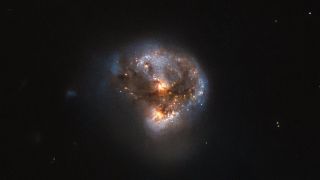Pew, pew! Scientists detect record-breaking 'megamaser' 5 billion light-years away
Meet Nkalakatha, or "big boss."

In just one night of observing, scientists detected a new record-breaker — the most distant megamaser known to date.
A megamaser is a super-powerful laser made of microwave light (hence maser). Megamasers come in a few different flavors, but the one the scientists detected is the most common type, which displays the signal of hydroxyl, a molecule made up of one atom of oxygen and one atom of hydrogen. The team argues that the newly detected megamaser, one of the brightest such beams known to date, marks a galactic collision.
"When two galaxies like the Milky Way and the Andromeda Galaxy collide, beams of light shoot out from the collision and can be seen at cosmological distances," Jeremy Darling, a coauthor on the new research and an astrophysicist at the University of Colorado, said in a statement released by the University of the Western Cape in South Africa, which participated in the research. "The OH [hydroxyl] megamasers act like bright lights that say: here is a collision of galaxies that is making new stars and feeding massive black holes."
Related: 'Fireworks' images from Hubble Telescope capture stars forming just after the Big Bang
"Megamasers emerge out of maximal chaos," Hayley Roberts, a coauthor on the new research and an astrophysics graduate student at Colorado University Boulder, said in another statement.
The detection comes courtesy of the MeerKAT array, a collection of 64 receptors spread across a patch of South Africa. The array had started a new project looking for hydrogen signals in the distant universe, targeting what one of the researchers called a "cosmic vuvuzela," a horn stretching out so far that it will allow scientists to see the universe as it looked when it was less than 5 billion years old.
(The project is called Looking at the Distant Universe with the MeerKAT Array, or Laduma, which means "it thunders" in the Zulu language and which South African soccer fans yell to celebrate goals, the project website explains.The vuvuzela noisemaker was particularly popular around the 2010 World Cup, which was held in South Africa.)
Get the Space.com Newsletter
Breaking space news, the latest updates on rocket launches, skywatching events and more!
The Laduma project will entail more than 3,000 hours of observing time — but scientists didn't have to wait nearly that long to make discoveries.

"It's impressive that, with just a single night of observations, we've already found a record-breaking megamaser," Marcin Glowacki, lead author of the new research and an astronomer at Curtin University in Australia, said in a university statement. "It shows just how good the telescope is."
The scientists have dubbed the megamaser Nkalakatha, which means "big boss" in isiZulu, one of the official languages of South Africa, on the suggestion of a student.
Nkalakatha emanates from a galaxy with a long, radio-bright tail on one side, according to the statement, and its light is about 5 billion years old.
And Nkalakatha won't be the only megamaser that the research project can add to the cosmic map. "MeerKAT will probably double the known number of these rare phenomena," Darling said. "Galaxies were thought to merge more often in the past, and the newly discovered OH megamasers will allow us to test this hypothesis."
The results are described in a paper posted on Wednesday (April 6) to the preprint site arXiv.org and accepted for publication in the Astrophysical Journal Letters.
Editor's note: This article has been updated to correct author identifications. Email Meghan Bartels at mbartels@space.com or follow her on Twitter @meghanbartels. Follow us on Twitter @Spacedotcom and on Facebook.
Join our Space Forums to keep talking space on the latest missions, night sky and more! And if you have a news tip, correction or comment, let us know at: community@space.com.

Meghan is a senior writer at Space.com and has more than five years' experience as a science journalist based in New York City. She joined Space.com in July 2018, with previous writing published in outlets including Newsweek and Audubon. Meghan earned an MA in science journalism from New York University and a BA in classics from Georgetown University, and in her free time she enjoys reading and visiting museums. Follow her on Twitter at @meghanbartels.
